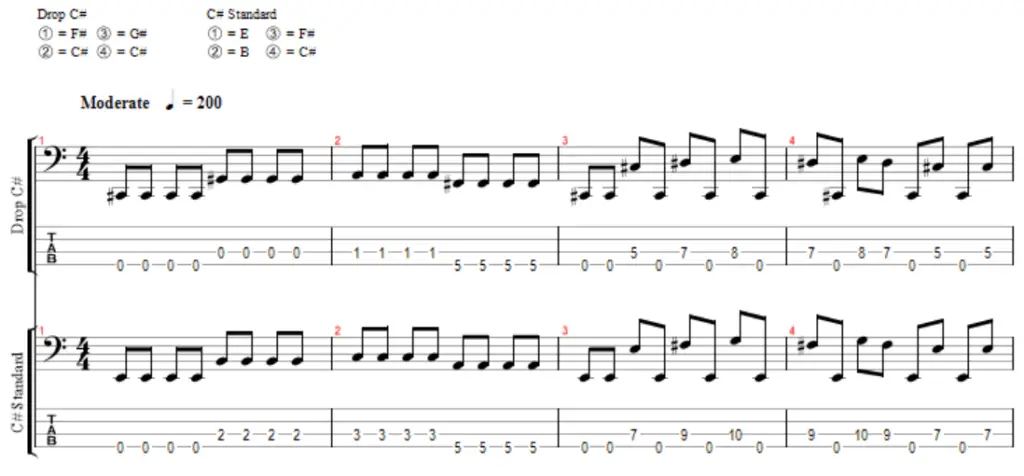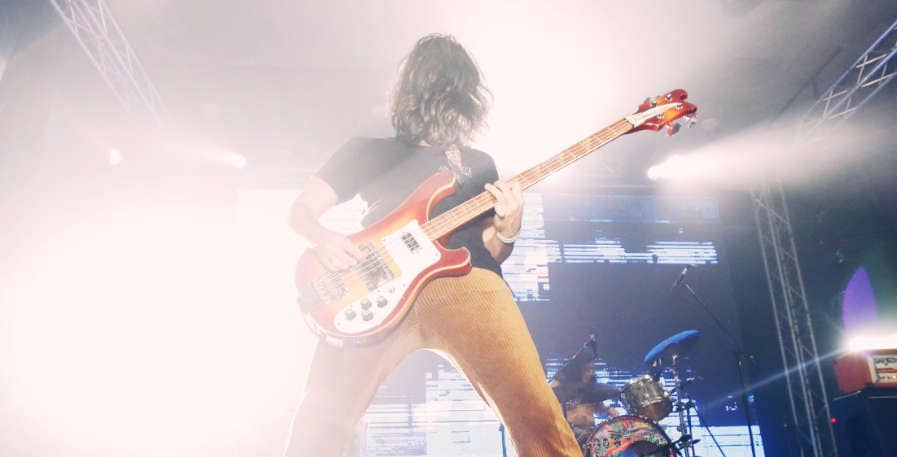Drop C#, also known as Drop Db, is a bass tuning with a lot of versatility. In the world of alternate bass tuning, I thus like to think of it as a jack of all trades.
While often overshadowed by Drop D, Drop C# holds many advantages over it. Also, bands that give Drop C sharp a try usually end up sticking with the tuning. Thus, it has become increasingly more popular through the years, especially in sub-genres of metal and rock.
However, setting your bass up for and playing in Drop C# is not as simple as tuning down your bass. Therefore, I decided to write this article to tell you all you need to know about Drop C sharp.
I will show you how to set up your bass so that you can get a heavy and resonant tone once you tune down. There is also a tuner below that you can use to easily tune your bass down to drop C#.
Last but not least, I`ll show you why to choose this tuning over other alternatives, and list some bands that have made great use of it.
What does Drop C sharp mean?
Drop C sharp means that the heaviest string of the bass is dropped down a whole step to C sharp. Therefore, the strings are tuned C#-G#-C#-F# on a 4-string bass, and C#-G#-C#-F#-B on a 5-string bass in this tuning.
Drop tunings differ from standard tunings in that the heaviest string and second heaviest string are tuned a perfect 5th apart, rather than a perfect 4th. The name comes from the string being “dropped” deeper than it would be in a standard tuning.
We get Drop C# from tuning our bass to Eb standard and tuning the deepest string down a whole step. Since C# is a whole step deeper than Eb, we call the resulting tuning Drop C#.

The reason bands tune to Drop C#
Any alternate bass tuning can make you sound heavier. So why choose to play in drop C sharp when there are so many other options out there? There are actually multiple reasons. These are the major ones:
Expanding on Eb standard
Eb standard is one of the most common alternate tunings in rock and metal. Drop C# retains the core characteristics of Eb standard while providing an additional whole step of deep range.
Thus, this tuning gives you the best of both worlds: The well-known sound of Eb standard, and a deep open string to play even heavier when need be.
Accommodating the vocalist
Vocalists who have a naturally deep range, or have lost some of their range due to age, can benefit from songs being played in a deeper key.
Drop C# works well for this purpose, as 1 and a half steps of additional deep reach is a lot when it comes to vocal ranges. Drop C# is thus a great solution for helping the vocalist out without changing the tone of the song completely. This is because the tuning makes transposing a song either a half-step or 1 and a half-step down easy.
The melancholy characteristic
An open C sharp string makes it significantly easier to write songs in C sharp minor. This is a key that is often used in symphonic metal and melodic death metal due to its melancholy character.
This makes Drop C# a great tuning for bands that want to sound heavy while incorporating sad and beautiful melodies as well.
Middle ground
Drop C# hits a sweet spot where the open C sharp is heavy, but not too heavy.
When E standard isn`t heavy enough, and Drop A sounds excessively deep, Drop C# serves as a good middle ground. This makes the tuning especially appealing for heavy bands that still want to garner a large audience.
Genre Fluidity
This is also a tuning that allows you to play a multitude of genres. For example, it is perfectly possible to play both classic rock and melodic death metal in Drop C#.
Thus, it is a great tuning for bands that play a multitude of genres, or that like to blend genres together.
What bands use Drop C sharp?
Drop C sharp is most commonly used by hard rock and metal bands. Within the confines of these genres, it is however a versatile tuning. Because of this, it has been used in everything from mainstream rock hits to post-hardcore and death metal.
To get a feel for how the tuning can be used in various genres, here`s a list of noteworthy bands that have released music in Drop C#:
| Band: | Bassist: | Genre: | Notable songs in Drop C#: |
| Pierce The Veil | Jaime Preciado | Post-Hardcore | Bulls In The Bronx, Caraphernelia |
| Lamb Of God | John Campbell | Death Metal | Grace, Reclamation |
| Biffy Clyro | James Johnston | Rock | Mountains, Black Chandelier |
| System Of A Down | Shavo Odadjian | Alternative Metal | B.Y.O.B, Lonely Day |
| Alexisonfire | Chris Steele | Post-Hardcore | Accidents, This Could Be Anywhere In The World |
| Trivium | Paolo Gregoletto | Heavy Metal | In Waves, Vengeance Falls |
| Linkin Park | Dave “Phoenix” Farrell | Nu-Metal | Numb, Breaking The Habit |
| Skillet | John Cooper | Hard Rock / Symphonic Metal | Rebirthing, Hero |
| Of Mice And Men | Aaron Pauley | Metalcore | Second And Sebring, |
| Black Veil Brides | Lonny Eagleton (2019 onward) Ashley Purdy (2009-2019) | Heavy Metal | In The End, Perfect Weapon |
| Disturbed | John Moyer | Alternative Metal | Down With The sickness, Ten Thousand Fists |

Setting a bass up for Drop C#
Below is a tuner that you can use to tune your bass to Drop C sharp. Before we get to that though, I want to show you some of the steps you might need to take in order for your bass to sound good in the tuning:
- Get a thicker low string- Since your E string is being tuned down 1 and a half steps, you will greatly benefit from switching to a thicker string. A .105 string commonly used for E standard will still be somewhat playable, but it will feel excessively loose and not sound as resonant and heavy as a thicker string would. You do not have to switch out the rest of your strings, as they are just tuned down half a step.
- File the nut – Depending on the gauge of your new C# string, it could struggle to fit into the nut of the bass. Therefore, you might need to file the nut slightly in order for the string to fit into it. If the string is too big for the cut in the nut, this will result in an unstable string and higher action.
- Adjust Action – Switching to a thicker string can end up causing high action. Thus, after stringing your new string and tuning it down, measure and adjust the action accordingly to ensure that the bass feels playable.
All of these steps of a bass setup can be done at home. In the case of Drop C#, it is a lot more straightforward than with other alternate tunings, as just changing out one string will not have a major impact on the bass. Still, neglecting these steps altogether will have a negative impact on the sound and playability of your instrument.
An alternative is to get your bass set up by a Luthier. I`ve researched the average cost of bass setups, and found that with new strings the average cost is $79.54.
How do I tune my bass to drop C sharp?
A bass guitar is tuned to Drop C sharp by tuning every string down half a step from E standard. The deepest string is tuned down an additional whole step, resulting in a C#-G#-C#-F# tuning, with an additional high B on 5-string basses.
In order to make this easy for you, I made a bass tuner for tuning to C# spesifically. Start with the deepest string and continue by matching your strings to the pitches below:
C#1 (Deepest string):
G#1:
C#2:
F#2:
B2 (Use this pitch for the thinnest string on 5-string basses):

Bass string gauges for Drop C#
A balanced set of bass strings in Drop C# has gauges of .120-.085-.070-.050, with an added .040 for 5-string basses. Strings that are suited for E standard can be used without issue for every string except the low C#. For the deepest string, it is a best practice to use a string in the .120 to .110 gauge range.
Ernie Ball recommends a deep 110 string for D standard and Drop C. Thus it is fair to assume they would recommend it for Drop C# as well. However, this gauge is on the thinner side when compared to what strings bassists commonly use for this tuning.
Bassists most commonly use a .115 or a .120 for the deep string. Some use .110 and.125 as well. Both a .110 and .125 will work, but these gauges start to push the boundaries of being too thin or too thick.
A .120 gauge C# string will give you a rumbly tone and a slightly looser string, but not excessively so.
Thus, If you are aiming for as heavy of a sound as possible and are looking to play either rock or metal, this is my recommendation. A .115 will also work and is also generally a better fit for non-heavy genres.
As for the rest of the strings, anything that works in E will also work for Drop C sharp. Tuning the strings a half step down will not make or break their sound. If you still find that they sound too thin, you can opt for a slightly heavier set, such as this one from Rotosound.
Thus, my recommendation is to use your current set of strings if you are currently tuned to E, but switch the E string out with a .120. As for string type, I recommend a nickel-plated Roundwound string for a bright and sturdy tone. Single .120s are available from several manufacturers, such as D’Addario:
Drop C# VS C# Standard
If you are used to playing in a standard tuning, playing in a drop tuning can take a little bit of getting used to.
This is mainly because you have to get used to the 2 deepest strings being tuned further apart. As a result, you might need to find new finger patterns and rethink how to play some grooves.
Below is an example of the same metal bassline played in Drop C# and C# standard. Because the second thickest string is tuned a whole step deeper in C# standard, the riffs need to be played differently:

Playing in a drop tuning also makes power chords easier to play, as they can be played with 1 finger instead of 2. As a result, many guitarists love dropping their lowest string, while it is not as big of a deal for bassists.
The tuning of your guitar players can however have a big impact on you when playing in a band. If they are playing in Drop C#, it is generally a best practice to do the same.
While you can still play in C# standard, this will require you to transpose riffs, and some grooves can end up having awkward finger patterns. In return, you get to play in a standard tuning, which means you can retain your muscle memory and knowledge of the fretboard. For inexperienced bassists, I recommend playing in the same tuning.
If your guitarists are playing in C# standard, playing in Drop C# is in my opinion redundant as a bassist. You can however opt to do so if you prefer playing in a drop tuning, over a standard tuning.
Conclusion
Drop C sharp, or Drop D flat is a bass tuning that requires minimal setup, yet has many benefits. It has a great amount of deep range, but not excessively much. It also has most of the same benefits as playing in Eb standard.
By getting a .120 or.115 roundwound string for the low C#, you are setting yourself up to get a heavy and resonant tone. You will likely need to file the nut and adjust the action of your bass to accommodate the new string.
Once this is done, you can play everything from radio rock to death metal on the same bass. Feel free to check out some of the artists I listed above that play in Drop C# to truly get an idea of how versatile this tuning can be. After tuning down, it might not even be long before you make your way onto the list yourself.
Are you tuning to Drop C# to play metal? In that case, feel free to read some of my guides on how to do well as a metal bassist. In particular, I recommend checking out my guide on Metal Bass EQ and Amp Settings.

